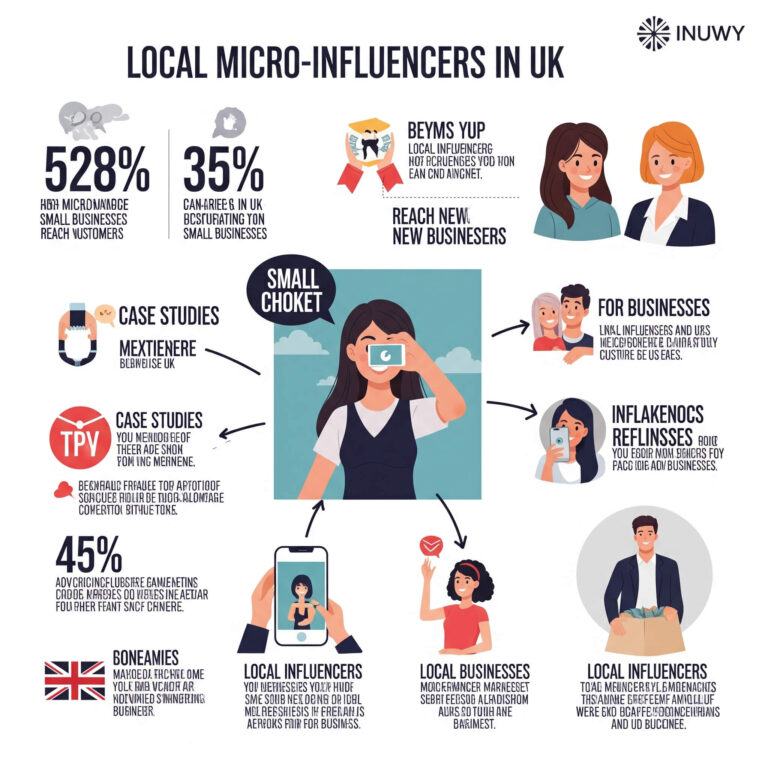The digital landscape is rapidly evolving, and social media has become one of the most influential channels for businesses to reach their target audience. While major corporations often opt for celebrity endorsements and macro-influencers, smaller businesses in the UK are turning to a more personalized and cost-effective approach: collaborating with local micro-influencers.
This emerging trend is not a passing phase. It’s a calculated, data-supported strategy that allows small businesses to make a significant impact in their local markets. By leveraging micro-influencers, businesses can enhance engagement, cultivate trust, and keep marketing costs under control.
What Defines a Micro-Influencer?
Micro-influencers are social media personalities who typically have between 1,000 and 100,000 followers. Unlike high-profile celebrities, they tend to have niche interests and foster close-knit relationships with their audiences. These influencers can be anyone from local food bloggers and fitness enthusiasts to fashion experts or hobbyist content creators.
What sets micro-influencers apart is their authenticity and the ability to directly connect with their followers, often driving higher engagement and trust within specific communities.
Why Micro-Influencers Are a Game-Changer for Small Businesses
Small businesses often face limitations, such as budget constraints and a smaller marketing team. However, micro-influencers offer a solution that caters specifically to these challenges:
Cost-Effective Marketing
Compared to high-budget national campaigns, partnering with micro-influencers is an affordable option. Many micro-influencers are open to collaborating in exchange for free products, modest fees (typically ranging from £50 to £300 per post), or affiliate commissions. This makes influencer marketing accessible even for businesses with limited resources.Stronger Local Engagement
Micro-influencers tend to be based in the same areas as their followers. Their recommendations resonate with local audiences, often leading to increased foot traffic, in-store visits, and attendance at local events.Exceptional Engagement Rates
Micro-influencers frequently see engagement rates of 6–10%, compared to the much lower 1–2% engagement rate of macro-influencers. This means more direct interactions, higher visibility, and greater potential for driving sales and customer loyalty.
Case Studies: How Micro-Influencers Are Driving Growth
1. Rose & Thread – A Cardiff Boutique
Strategy: Partnered with local micro-influencers on Instagram to promote new arrivals.
Results:
Instagram followers increased from 1,400 to 3,200 in just one month.
Online orders skyrocketed from 12 to 49 per month.
Foot traffic to the store saw a noticeable uptick.
2. Green Spoon Café – A Vegan Café in Sheffield
Strategy: Invited local vegan influencers to cover their soft opening event.
Results:
Received 100+ mentions on Instagram.
Featured in a popular local Sheffield blog.
Achieved a 35% increase in revenue in just two months.
How to Find the Right Micro-Influencer for Your Business
Selecting the right micro-influencer can significantly impact the success of your campaign. Here are some important factors to consider when making your choice:
Key Considerations
| Factor | Why It’s Important |
|---|---|
| Location | Influencers should be local to your business for maximum impact. |
| Niche | Their content should align with your business and target audience. |
| Engagement Rate | High engagement indicates a dedicated and active audience. |
| Content Quality | Their posts should reflect the tone and values of your brand. |
| Past Collaborations | Ensure their previous partnerships are authentic and aligned with your brand’s values. |
Where to Find Micro-Influencers
Social media platforms like Instagram and TikTok use hashtags such as #LocalBusinessUK, #LondonEats, or #SmallBizSupport.
Influencer platforms like Heepsy or Upfluence.
Attend local events and markets where influencers might be engaging with your target audience.
Effective Campaign Ideas for Collaborating with Micro-Influencers
There are numerous ways to collaborate with micro-influencers to suit your business goals. Here are some popular strategies:
Sponsored Posts
The influencer shares a post about your product or service, either as a sponsored post or in an Instagram story.Giveaways & Contests
Host a giveaway or contest that encourages audience interaction and spreads awareness about your business.Product Reviews and Unboxings
Have the influencer share their experience with your product through a detailed review or unboxing video.Event Coverage and Store Visits
Invite influencers to your store or event, where they can share live updates and bring their audience along for the experience.
Tips for a Successful Micro-Influencer Partnership
To ensure a long-term, fruitful relationship with your influencers, keep these tips in mind:
Maintain Transparency: Communicate your expectations and what you will provide in return.
Allow Creative Freedom: Influencers know their audience best, so let them express their creativity.
Track Success: Use affiliate links or unique promo codes to track the effectiveness of the campaign.
Cultivate Relationships: Instead of treating the collaboration as a one-off event, focus on building long-term relationships with influencers.
FAQs: Micro-Influencers and Local Business Growth
Q1: What qualifies someone as a micro-influencer?
A micro-influencer typically has between 1,000 and 100,000 followers and is known for high engagement within a specific niche.
Q2: What are the costs of working with UK-based micro-influencers?
Typically, costs range from £50 to £300 per post, depending on the influencer’s niche, engagement, and location.
Q3: Can service-based businesses benefit from micro-influencers?
Yes, influencers promote services like fitness coaching, photography, and wellness just as they do physical products.
Q4: What’s the most effective platform for micro-influencer marketing?
Instagram remains the most popular platform, but TikTok is quickly gaining traction among younger audiences.
Q5: How can I measure the ROI of my influencer campaign?
Track ROI by using promo codes, affiliate links, and Google Analytics to assess the traffic, sales, and conversions driven by the influencer.
Conclusion
For small businesses in the UK, partnering with local micro-influencers can be a game-changer. These influencers provide a unique opportunity to engage directly with the local community, build authentic relationships, and boost brand visibility all while staying within budget. By working with micro-influencers, businesses can not only enhance their online presence but also foster meaningful connections with their target audience, ultimately driving growth and success.


